布拉索夫中央广场的圣诞市集,罗马尼亚 Christmas Market in Main Square of Braşov, Romania (© Alpineguide/Alamy)
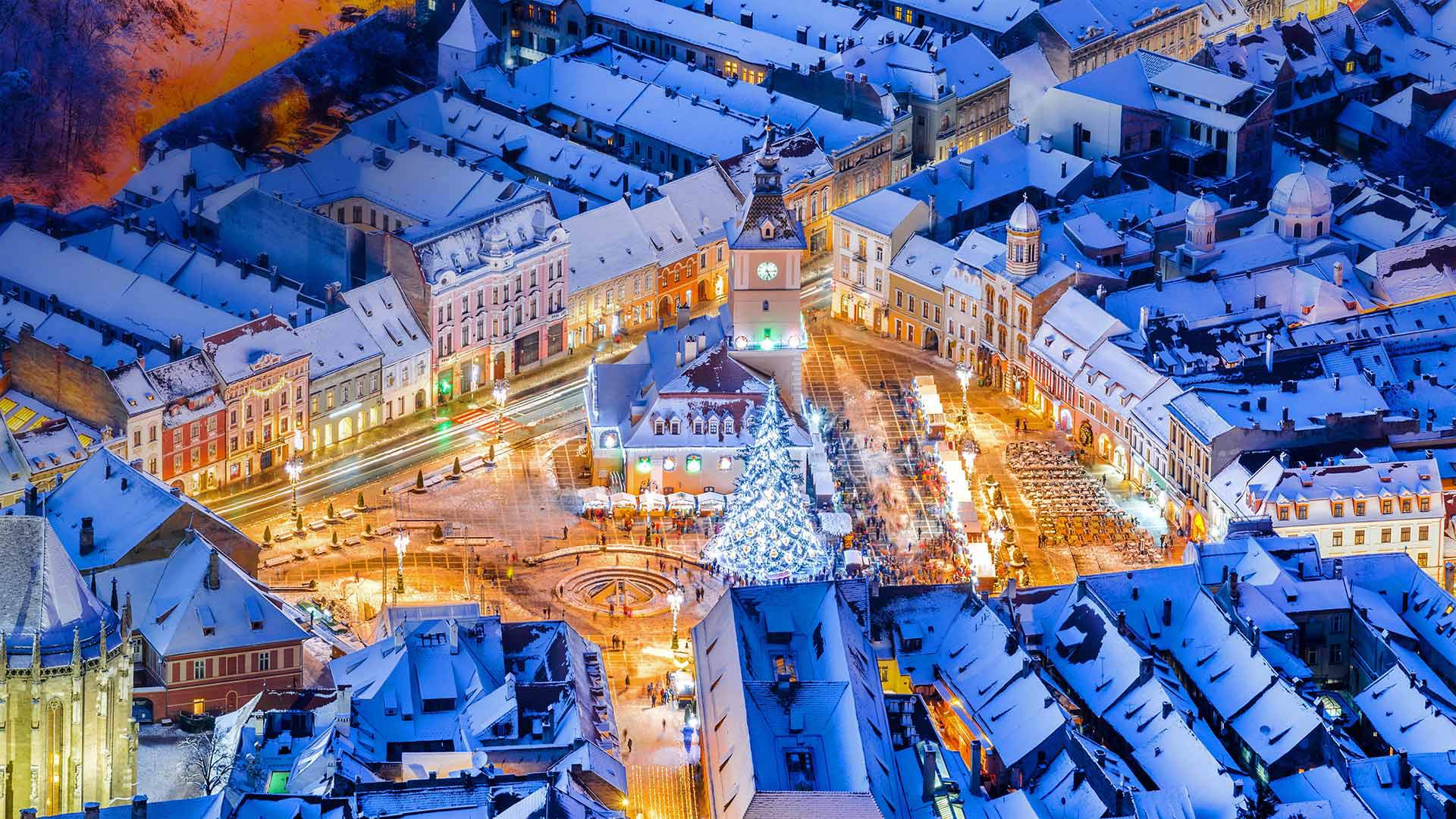
布拉索夫中央广场的圣诞市集,罗马尼亚 Christmas Market in Main Square of Braşov, Romania (© Alpineguide/Alamy)
A Carpathian Christmas celebration
Nestled at the foot of Mount Tampa in the southern Carpathian Mountains of Romania, Brașov is a wonderful example of medieval Europe's intersecting cultures. Founded by Teutonic Knights, settled by Saxons and Hungarians, influenced by the Ottoman Empire, the Tartars, and the native Romanians, the city's Gothic architecture and unique cuisine reflect its rich history. The city's Christmas market is held throughout the month of December and is dominated by a 90-foot-tall, live Christmas tree. The market's numerous stalls feature food, drink, and local crafts.
The festival is known as 'Braşov—the city from the tales,' perhaps because legend has it that this square is where the children of Hamelin emerged after being led away by the Pied Piper. However you arrive, it's a magical place to drink a cup of cheer and toast to your Romanian hosts with a hearty 'Noroc!' But even if you're keeping it local this year, it's easy to be warmed even by the image of this golden glow from 'the city from the tales.'
喀尔巴阡山的圣诞庆典
布拉索夫坐落在罗马尼亚喀尔巴阡山脉南部坦帕山脚下,是中世纪欧洲文化交融的一个极好的例子。由条顿骑士建立,撒克逊人和匈牙利人定居,受到奥斯曼帝国、鞑靼人和罗马尼亚土著人的影响,这座城市的哥特式建筑和独特的美食反映了它丰富的历史。这座城市的圣诞集市在整个12月举行,以一棵90英尺高的活圣诞树为中心。市场上有很多摊位,有食品、饮料和当地工艺品。
这个节日被称为“传说中的城市”,也许是因为传说这个广场是哈梅林的孩子们在被派笛手领走后出现的地方。不管你到了哪里,这里都是一个神奇的地方,你可以在这里喝上一杯干杯,并用一口热情洋溢的“诺洛克”为你的罗马尼亚东道主干杯。但即使你今年把它保留在当地,也很容易被“传说中的城市”发出的金色光芒所温暖。
基奈峡湾国家公园的尖顶湾,阿拉斯加 Cove of Spires in Kenai Fjords National Park, Alaska (© Sekar B/Shutterstock)
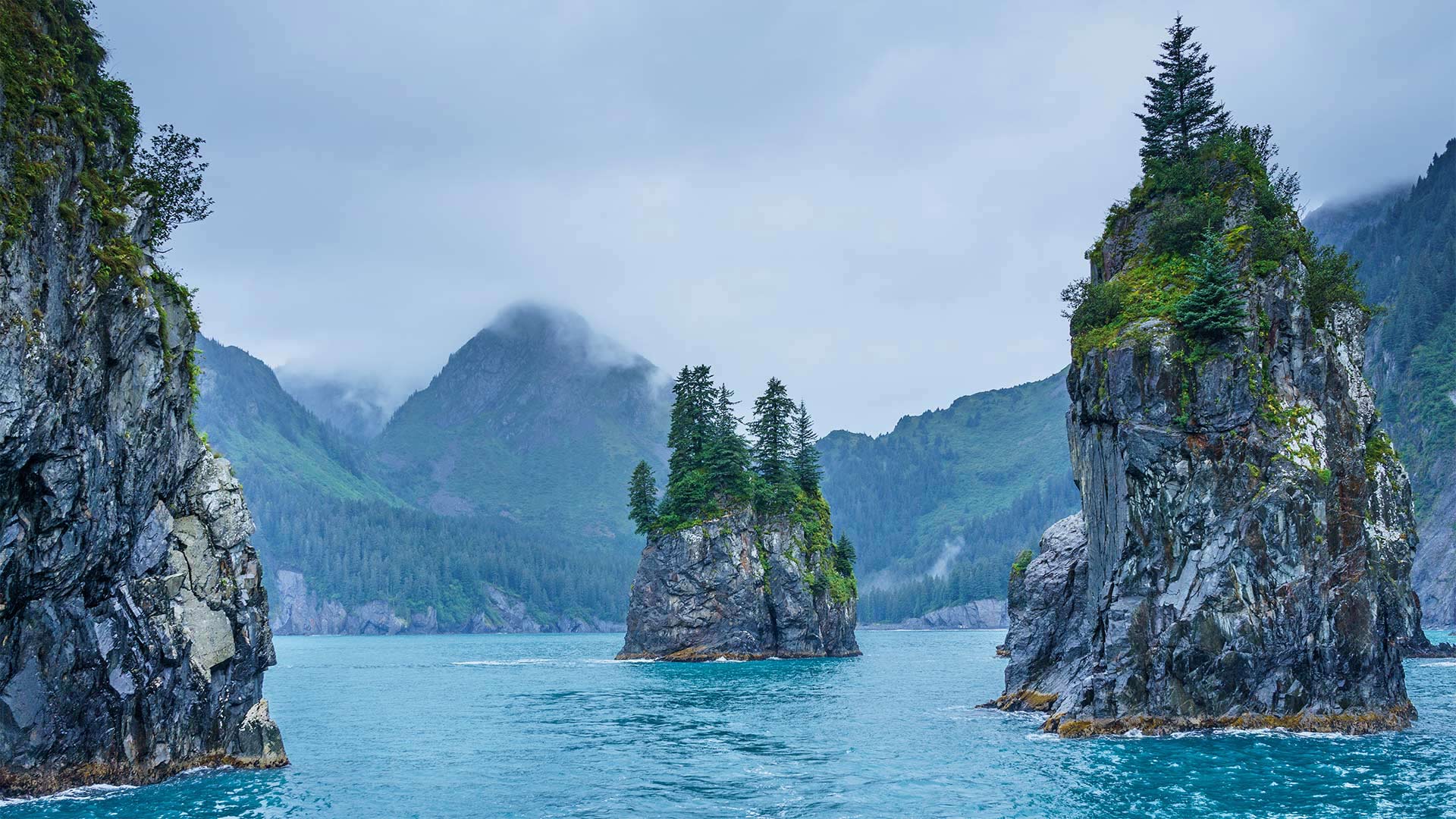
基奈峡湾国家公园的尖顶湾,阿拉斯加 Cove of Spires in Kenai Fjords National Park, Alaska (© Sekar B/Shutterstock)
Protecting Alaska
On this day in 1980, President Jimmy Carter signed into law the Alaska National Interest Lands Conservation Act, which converted massive tracts of Alaskan wilderness into protected land. That single act 40 years ago doubled the size of the entire national park system. Alaska's eight national parks cover more than 54 million acres. The Cove of Spires, shown here, is just one of the dramatic glacial landscapes that you can experience in Kenai Fjords National Park. Located near Seward, Alaska, the park is home to 38 glaciers which cover over half the park's area in ice—though climate change has reduced that drastically over the last decades.
杜拉通河谷中的Nuestra Señora de la Hoz老修道院,西班牙塞哥维亚 Nuestra Señora de la Hoz, an old monastery in the Duratón River gorge, Segovia, Castile and León, Spain (© Arco Images GmbH/Alamy)
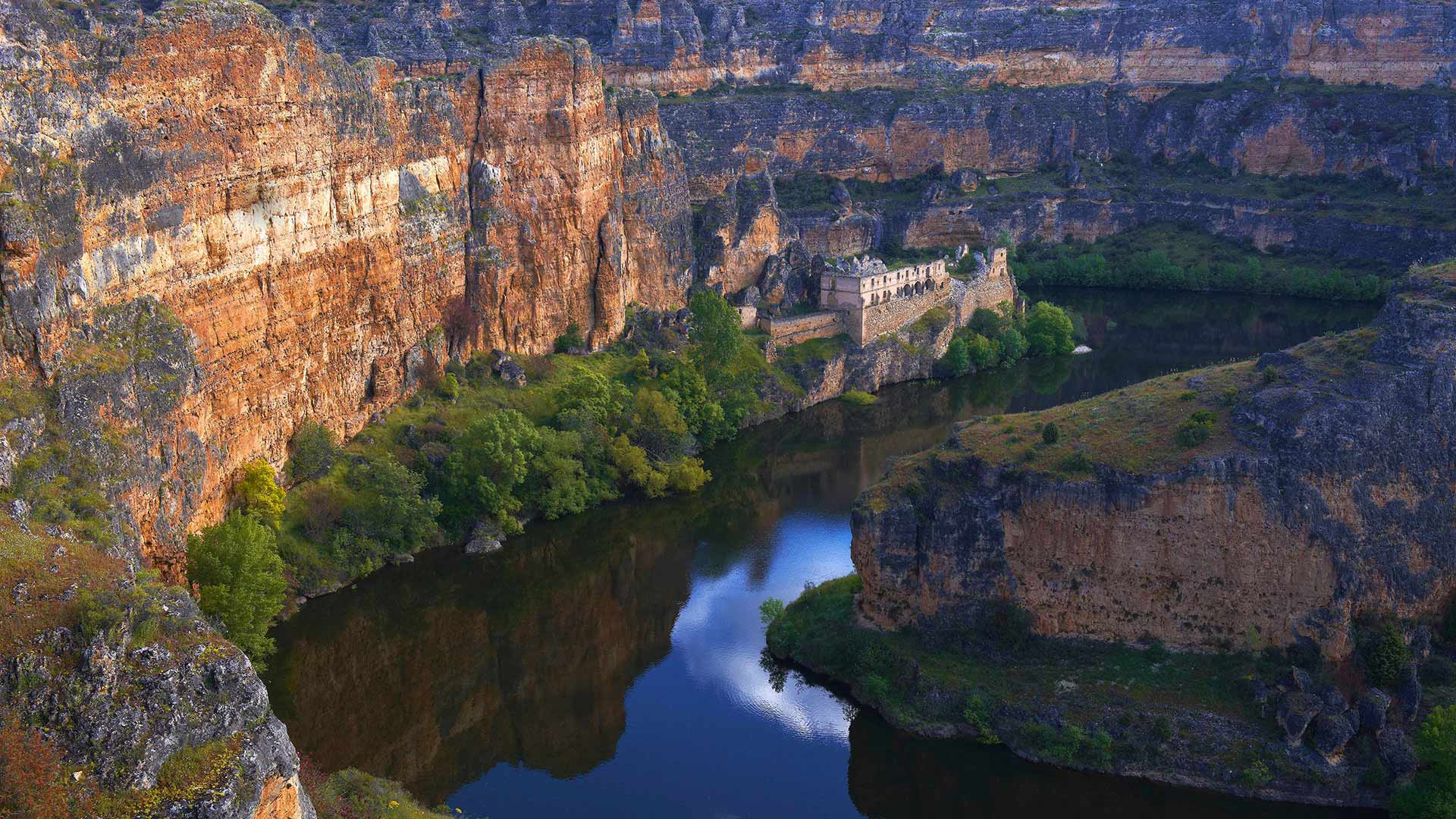
杜拉通河谷中的Nuestra Señora de la Hoz老修道院,西班牙塞哥维亚 Nuestra Señora de la Hoz, an old monastery in the Duratón River gorge, Segovia, Castile and León, Spain (© Arco Images GmbH/Alamy)
A gorge-ous spot for a monastery
Lace up your walking shoes and let’s head into the Hoces del Rio Duratón, in the Spanish region of Castile and León. This imposing 17-mile-long limestone gorge boasts towering vertical walls that can reach up to 100 metres high. The Duratón river which carved it meanders through a landscape rich in history and archaeological treasures.
Inside the cliffs are several caves with ancient paintings dating back to the Bronze Age, and a dark Visigothic grotto which is thought to be the first Christian temple in the region. Above one of the bends in the canyon sits a 12th century Romanesque church, just a few miles away from the ruins of the long-abandoned and isolated Franciscan monastery you see in our homepage image.
艾琳多南堡,苏格兰 Eilean Donan Castle in Scotland (© CBW/Alamy)
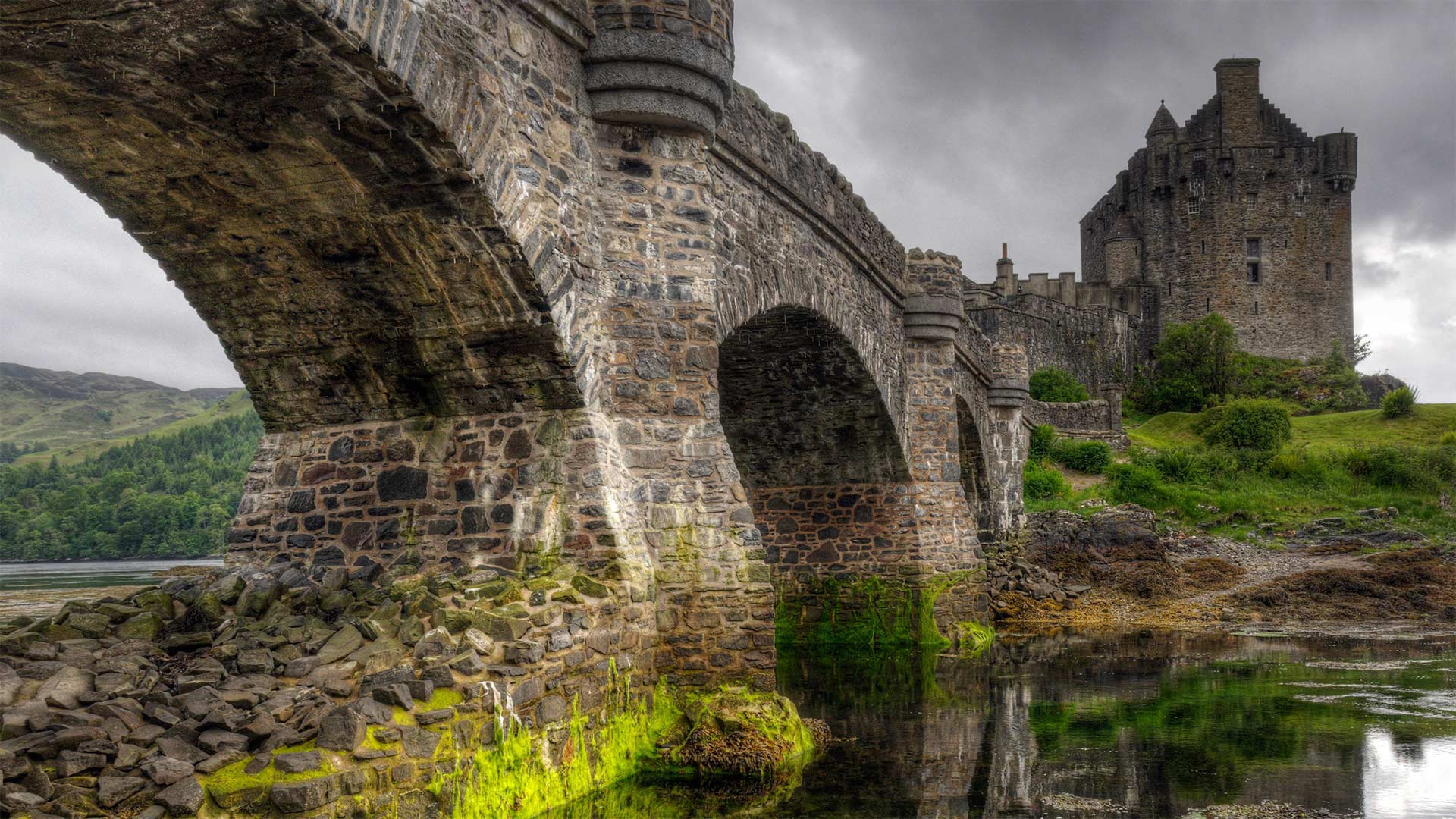
艾琳多南堡,苏格兰 Eilean Donan Castle in Scotland (© CBW/Alamy)
A water loch-ed castle
Located on a small island where three sea lochs meet in northwestern Scotland, the current Eilean Donan Castle is just the latest incarnation of several monastic cells and Scottish clan strongholds that have occupied the small island since the 7th century. The first fortified castle was built in the 13th century to defend against invading Vikings who occupied much of Scotland at the time. An iconic symbol of Scotland, from the 14th-18th centuries, the castle was mostly held by the Mackenzies and defended by the Macraes, both storied clans of the Scottish Highlands. The castle was destroyed in 1719 by the invading British Royal Navy during the Jacobite Uprising, but was rebuilt along its earlier design in the early 20th century by Lt. Colonel John Macrae-Gilstrap.
塔拉纳基山,新西兰艾格蒙特国家公园 Mount Taranaki, Egmont National Park, North Island, New Zealand (© Francesco Vaninetti/plainpicture)
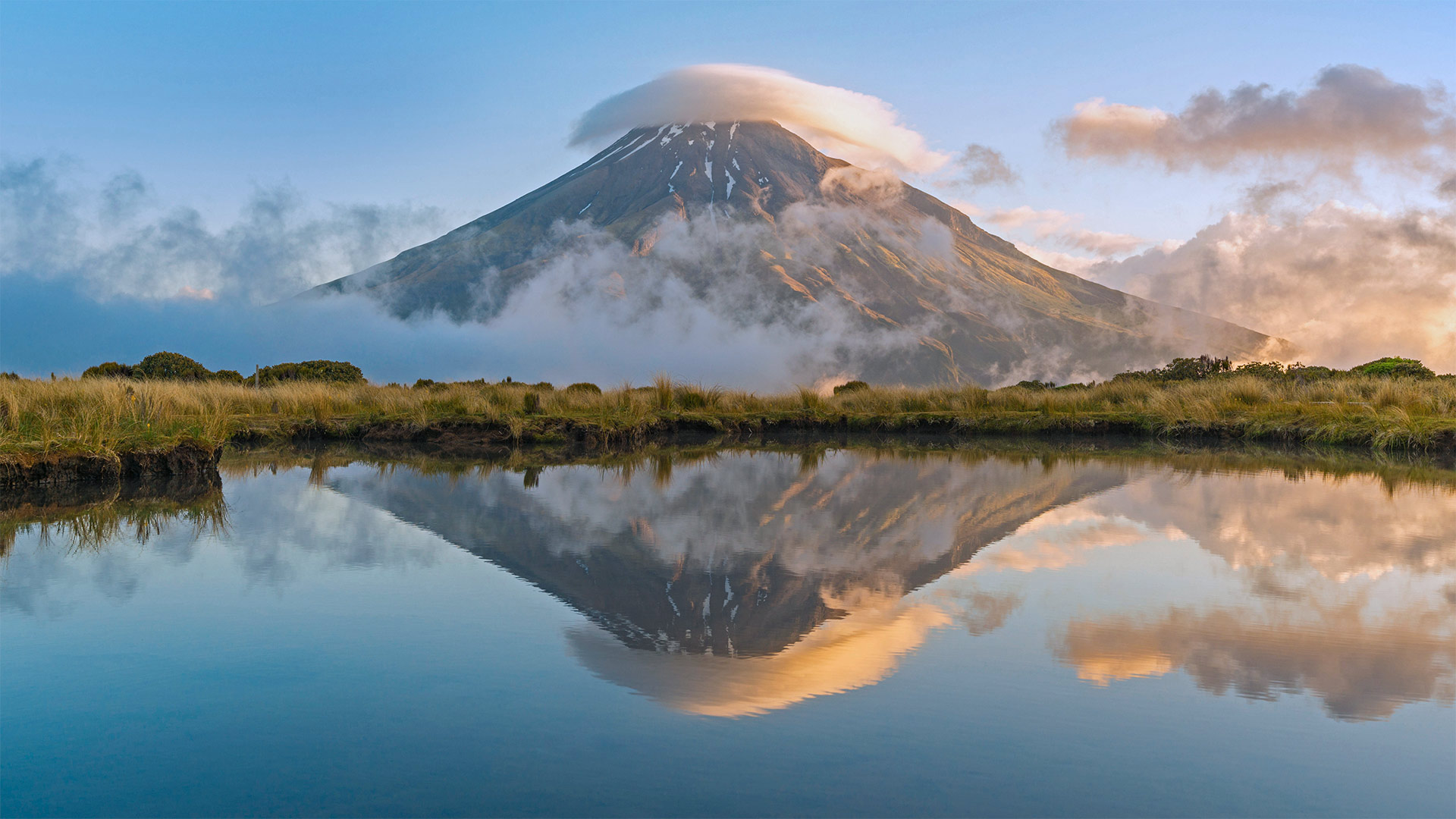
塔拉纳基山,新西兰艾格蒙特国家公园 Mount Taranaki, Egmont National Park, North Island, New Zealand (© Francesco Vaninetti/plainpicture)
New Zealand's loneliest mountain
According to the legends of New Zealand's aboriginal Māori people, the lonely Mount Taranaki wasn't always lonely. Taranaki, the story goes, once lived among other mountains in the North Island's center. But Taranaki feuded with the powerful volcano Tongariro over the love of the pretty peak Pīhanga. In their epic battle, the now flat-topped Tongariro lost his head but emerged victorious. The vanquished Taranaki wandered west, cutting trenches as he trudged to the shore and filling them with lovesick tears to create the region's rivers.
Now that Taranaki's settled in, the still-active stratovolcano's slopes and foothills comprise one of New Zealand's oldest national parks. Whether or not he's gotten over Pīhanga after untold millennia, Taranaki continues to compete with Tongariro even through modern myth: Taranaki had a star turn as Mount Fuji in background shots for 'The Last Samurai,' while the Tongariro area stood in for the cursed realm of Mordor in the 'Lord of the Rings' films.
部分被雪覆盖的Val Cervara山坡上的老山毛榉林,意大利蒙帕赛诺 Partly snow-covered slope in Val Cervara, an old-growth beech forest, in Abruzzo, Italy (© Bruno D'Amicis/Minden Pictures)
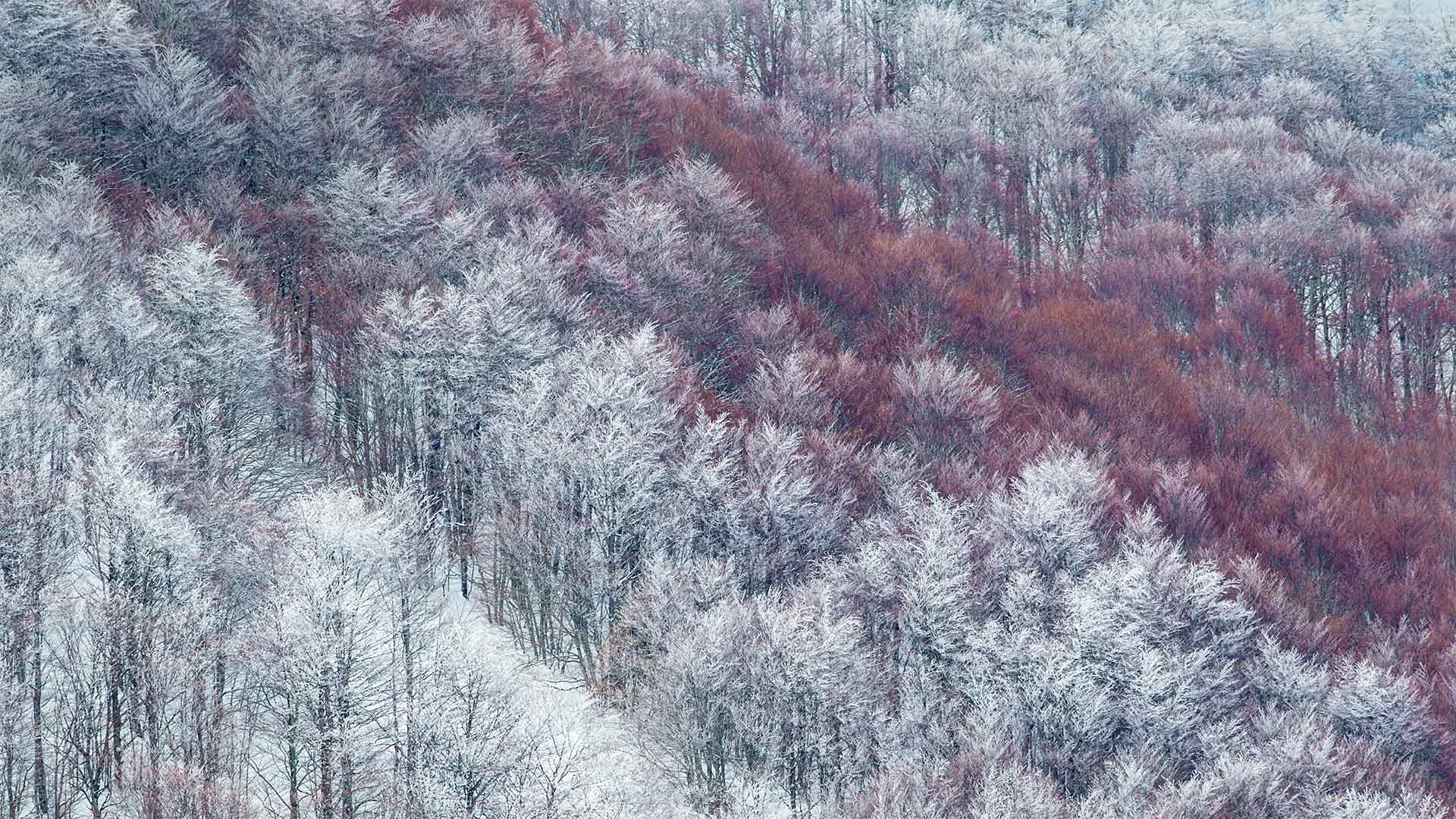
部分被雪覆盖的Val Cervara山坡上的老山毛榉林,意大利蒙帕赛诺 Partly snow-covered slope in Val Cervara, an old-growth beech forest, in Abruzzo, Italy (© Bruno D'Amicis/Minden Pictures)
Europe's oldest beech forest
Listen closely. Is that whistling you hear coming from a chamois, that great-antlered species of goat-antelope? Could it be the howls of an endangered wolf echoing off the mountainside? Or the bellowing of the Marsican brown bear, one of only 50 or so left on Earth? Most likely it's just the cold November wind blowing through this, the oldest beech tree forest in all of Europe. Hard to believe that this vast stand of primeval forest is just a two-hour drive east from Rome's busiest airport.
If Italy is a boot, then the National Park of Abruzzo is right in the middle of it, straddling the north and the south. While most tourists flock elsewhere in the country, a few nature seekers venture here to Abruzzo, the greenest part of Italy. Two-thirds of the park are covered in European beech tree forests, protected by their density. Shepherds, farmers, and loggers have never fully penetrated these forests. Hunters have, however, and some species, including the wolf and bear, have become gravely endangered. Hopefully, they, and the forest will thrive—UNESCO made this a protected site in 2017.
卡尔巴里国家公园,澳大利亚 Kalbarri National Park, Australia (© AWL Images/Offset by Shutterstock)
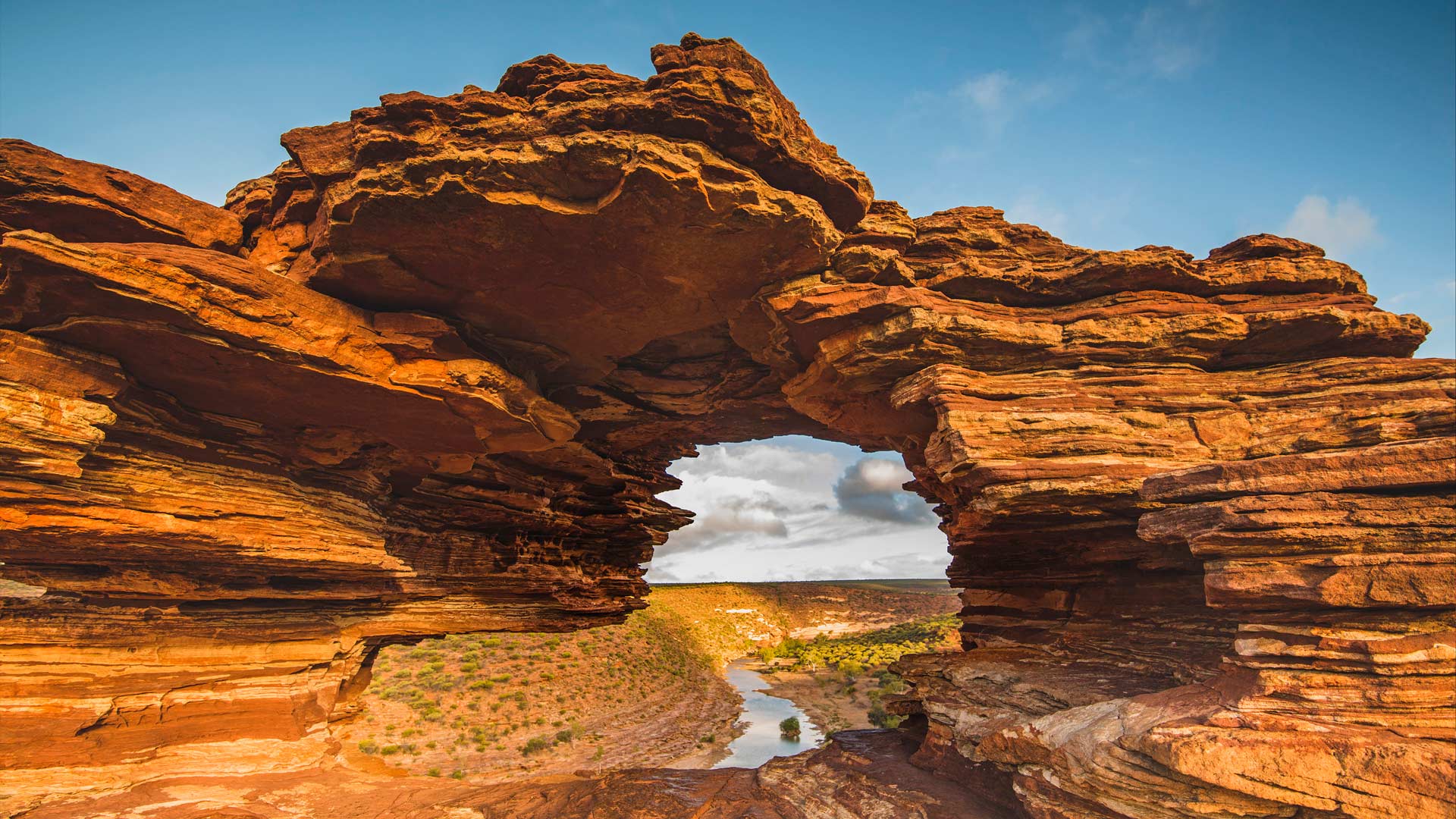
卡尔巴里国家公园,澳大利亚 Kalbarri National Park, Australia (© AWL Images/Offset by Shutterstock)
What a wonderful window
From planes to cafes, many of us love a nice ‘window view’, but we’d argue that few provide sights as truly spectacular as Nature’s Window here in Kalbarri National Park. Located 485 km north of Perth, the park covers around 186,000 hectares, and traditionally sees thousands of visitors each year to enjoy its rocky terrain and quiet peacefulness.
The main attraction, however, is this sandstone stunner – formed after many years of wind erosion. Find the perfect angle you’ll be able to catch incredible glimpses of the river in the distance and its surrounding greenery. It’s also one of the best places in the country to watch the sunrise. If you prefer a little more adventure, you can take a stroll to the Kalbarri Skywalk that shows off views of the gorge, or enjoy a spot of abseiling, rafting, and canoeing.
中央公园购物中心的美国榆树丛,纽约市 A grove of American elm trees in Central Park's Mall, New York City (© AWL Images/Danita Delimont)
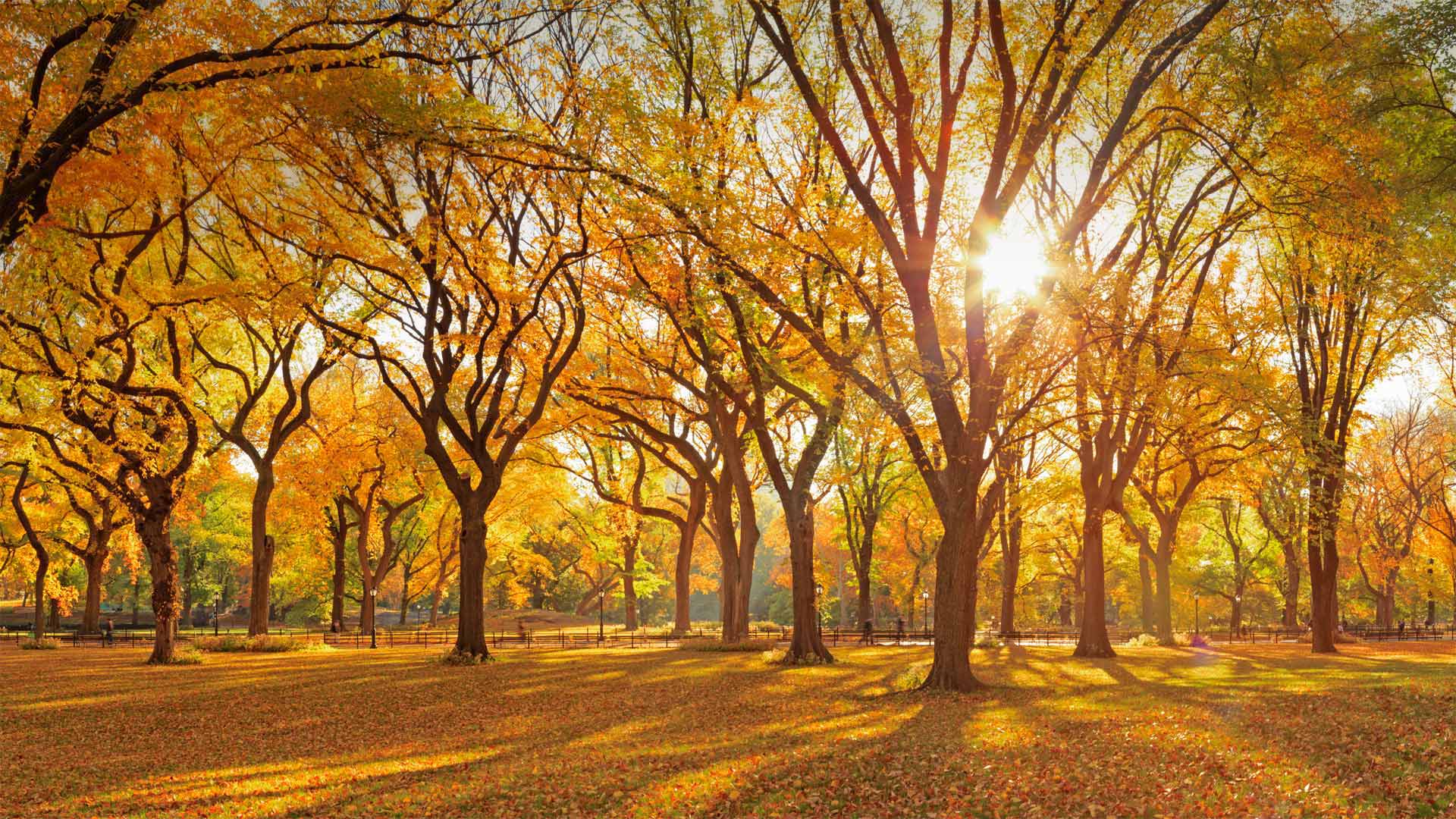
中央公园购物中心的美国榆树丛,纽约市 A grove of American elm trees in Central Park's Mall, New York City (© AWL Images/Danita Delimont)
A dying breed of tree thrives in an American park
We're standing in the Mall of New York City's Central Park, in the middle of fall foliage season. When Frederick Law Olmstead and Calvert Vaux designed this quarter-mile walkway, they were inspired by Europe's public spaces. They envisioned a 'grand promenade' where people of all backgrounds, from the city's monied elite to those of lesser status, could come together and mingle.
Today, the Mall remains one of Central Park's most popular and iconic features. Olmstead designed the pedestrian walkway to be the only straight path in all the park. Lining the path on either side is a majestic canopy made from hundreds of American elms. Chances are, you've seen an Elm Street in an American town or two. These majestic trees once populated many parts of the country but were devastated by Dutch elm disease beginning in the 1930s. The trees here in the Mall make up one of the oldest living stands of American elms in North America. They stand today, not only alive, but thriving, thanks to dedicated Central Park arborists who monitor and protect them. When a tree must be removed—in a bad year, the park can lose up to 35 trees—a new one is planted in its place.
巨浪冲击着阿斯洛玛尔州立海滩的岩石,加利福尼亚州帕西菲克格罗夫 Huge waves crashing on rocks along Asilomar State Beach, Pacific Grove, California (© Sheila Haddad/Danita Delimont)
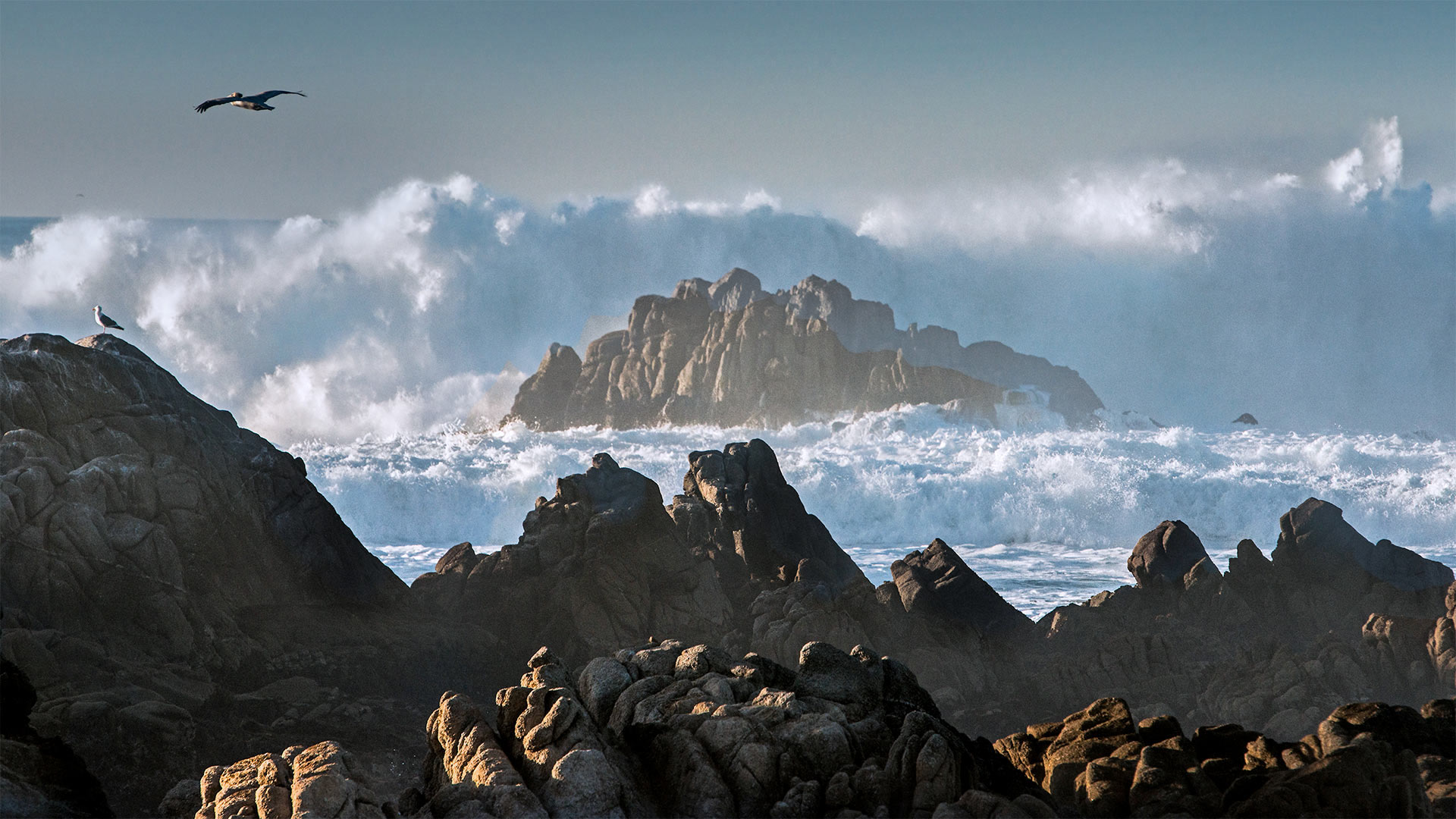
巨浪冲击着阿斯洛玛尔州立海滩的岩石,加利福尼亚州帕西菲克格罗夫 Huge waves crashing on rocks along Asilomar State Beach, Pacific Grove, California (© Sheila Haddad/Danita Delimont)
Feel the spray in Monterey
Fantasizing about warm, sandy beaches with gently lapping waves? Well, we decided you could use a shake-up—so here we are in Monterey County, California, for a glimpse at the ocean's raw, unadulterated power. Asilomar State Beach's mile-long coastline trail offers views like this one of seas crashing on jagged shores. Below the frothy surface swim innumerable ocean organisms protected by the massive Monterey Bay National Marine Sanctuary, the largest marine preserve in the contiguous United States. Behind us, a rich dune habitat supporting its own delicate flora and fauna can be explored via a boardwalk trail.
伯尔尼老城,瑞士 Old Town of Bern, Switzerland (© Simon Zenger/Alamy)
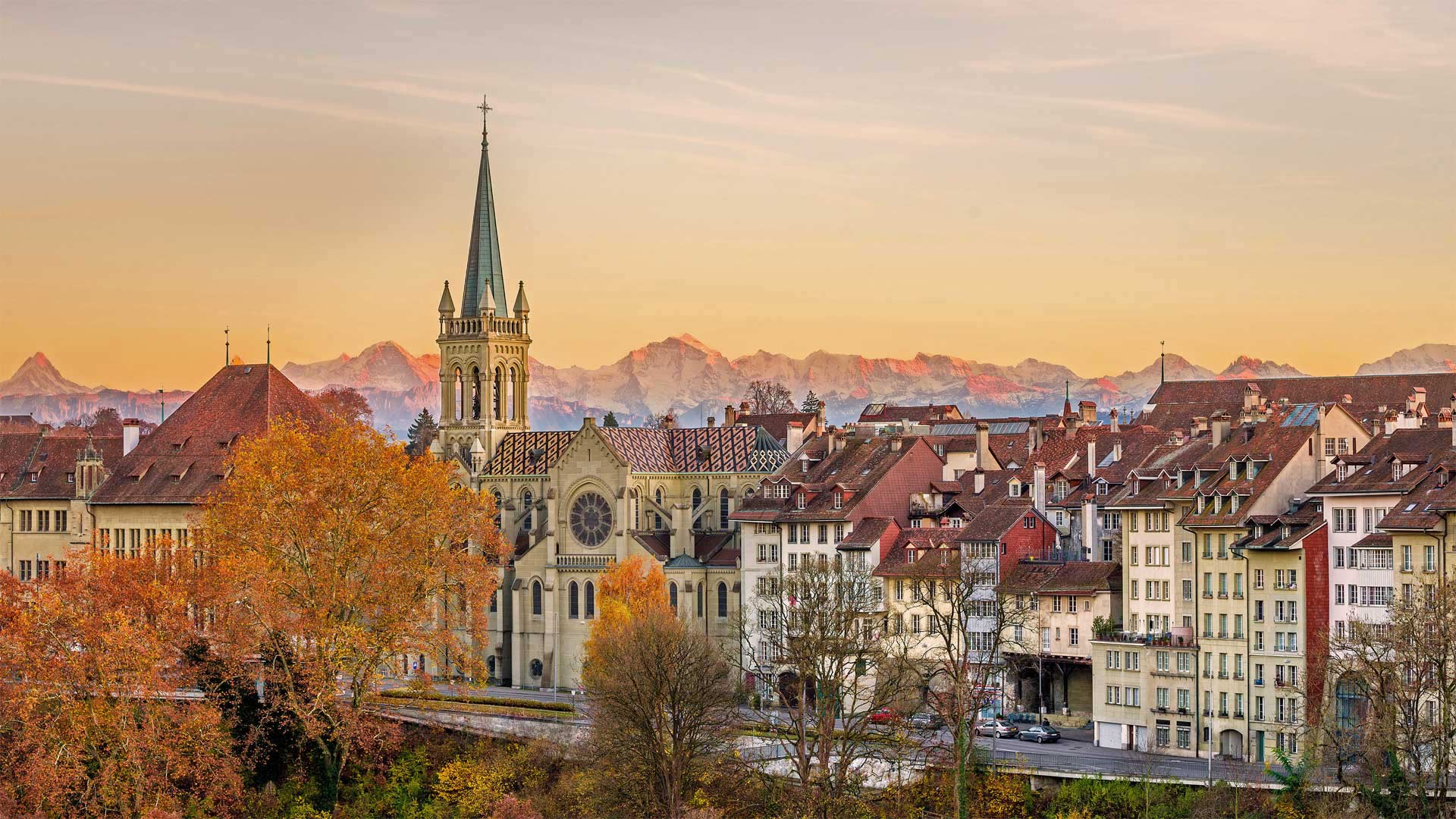
伯尔尼老城,瑞士 Old Town of Bern, Switzerland (© Simon Zenger/Alamy)
Autumn comes to Old Town
The medieval center of Bern, Switzerland's capital, looks much as it did when most of these buildings were first constructed between the 12th and the 15th centuries. What's now called Old Town was founded in 1191 on a long, narrow peninsula surrounded on three sides by the Aare River. As Bern grew over the centuries, it erected defensive walls and moats only to tear them down again with each successive wave of expansion. In their place are now broad public spaces for outdoor cafes and markets, like the Zibelemärit (Onion Market), an annual fall tradition.
Since at least the 1850s—and possibly much longer ago—the people of Bern have awakened very early on the fourth Monday of November to greet farmers who come to the city offering huge, beautiful garlands of onions and garlic for sale. This year, the coronavirus pandemic has put a stop to the public festival, but we're quite sure that on the streets of Bern's Old Town, the aroma of onion tarts and Glühwein is wafting out onto the streets from these perfectly preserved medieval houses.